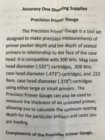What is the ID opening measurement on that depth gauge and how much travel does the pin have?
That looks like it would also be perfect for measuring pin fall on Remington 700 style bolts if it can be set to travel far enough.
the ID is compatible with 300 Win Mag, .308 and .223 case or .532" max
and it looks like I have .130 of pin travel if I measured it correctly











